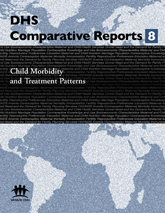- FEATURED

What child health-related data does The DHS Program collect?
DHS surveys routinely collect data on vaccination of children, prevalence and treatment of acute respiratory infections (ARI) and fever, and diarrhea. Prevention and treatment of malaria in children is usually presented in the malaria chapter of DHS final reports.
What are the DHS indicators related to child health?
- Vaccinations by source of information
- Vaccinations by background characteristics
- Prevalence and treatment of acute respiratory infection and of fever
- Diarrhea prevalence
- Hand-washing materials and facilities
- Disposal of child's stools
- Knowledge of diarrhea care
- Treatment of diarrhea
- Feeding practices during diarrhea
DHS surveys routinely collect data on infant and child mortality.
What are the SPA indicators related to child health?
SPA surveys collect a large range of child health service provision indicators. The SPA is designed to assess the availability of preventive services (such as immunization and growth monitoring) and outpatient care for sick children.
- Measuring Immunizations: The SPA examines adherence to the Expanded Program of Immunization (EPI) which includes one dose of TB (BCG) and measles vaccines and three doses of DPT and polio vaccines.
- Growth Monitoring: The SPA includes weighing of children and plotting the weight against standards to identify nutritional problems.
- Quality of Care for the Sick Child: The SPA assesses the availability of equipment, supplies and health system components necessary to provide quality outpatient care for sick children. Observation of the provider-patient interaction allows for evaluation of counseling and treatment, as well as adherence to IMCI (Integrated Management of Childhood Illness) protocols.
What is child health?
Child health refers to the period between birth and five years old when children are particularly vulnerable to disease, illness and death. From one month to five years of age, the main causes of death are pneumonia, diarrhea, malaria, measles and HIV. Malnutrition is estimated to contribute to more than one third of all child deaths.
Pneumonia is the prime cause of death in children under five years of age. Nearly three-quarters of all cases occur in just 15 countries. Addressing the major risk factors – including malnutrition and indoor air pollution – is essential to preventing pneumonia, as are vaccination and breastfeeding.
Diarrheal diseases are a leading cause of sickness and death among children in developing countries. Breastfeeding helps prevent diarrhea among young children. Treatment for sick children with oral rehydration salts (ORS) combined with zinc supplements is safe, cost-effective, and saves lives.
Though it is preventable with immunization, measles still kills an estimated 164,000 people each year – mostly children less than five years of age.
A major factor contributing to child mortality is malnutrition, which weakens children and reduces their resistance to disease. About 20 million children under five worldwide are severely malnourished.
